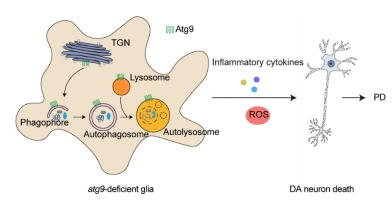中国神经再生研究(英文版) ›› 2024, Vol. 19 ›› Issue (5): 1150-1155.doi: 10.4103/1673-5374.382259
自噬相关蛋白Atg9调控果蝇帕金森病的进程
The autophagy protein Atg9 functions in glia and contributes to parkinsonian symptoms in a Drosophila model of Parkinson’s disease
Shuanglong Yi1, 2, Linfang Wang1, 2, Margaret S. Ho1, Shiping Zhang1, *
- 1School of Life Science and Technology, ShanghaiTech University, Shanghai, China; 2College of Life Sciences, University of Chinese Academy of Sciences, Beijing, China
摘要:
研究发现ATG9的分布异常与帕金森病密切相关,然而,ATG9在帕金森病中的确切作用,以及它是否在胶质细胞中发挥作用仍然未知。实验聚焦于胶质细胞Atg9的功能及致病机制研究,发现atg9在成年果蝇大脑胶质中高表达。通过免疫荧光染色和活细胞成像分析发现Atg9定位在胶质细胞的高尔基体、自噬体和溶酶体上,并与这些细胞器持续接触。RNA干扰(RNAi)敲降胶质细胞atg9的表达后,欧米茄体(Omegasome)和自噬体的数量减少,自噬底物的降解受到抑制,这表明与其他组织一样,胶质细胞Atg9调节自噬的早期步骤。重要的是,敲降胶质细胞atg9会诱发帕金森病相关症状,包括进行性多巴胺神经元损失和运动缺陷,以及胶质细胞活化。因此,该研究揭示了Atg9在胶质细胞中的自噬作用及其对帕金森病相关症状的调控作用,这些结果将为开发帕金森病的靶向治疗策略提供新的思路。
https://orcid.org/0000-0002-5706-0931 (Shiping Zhang)

